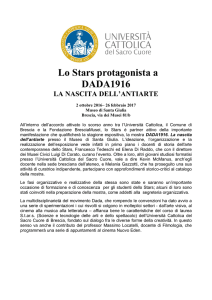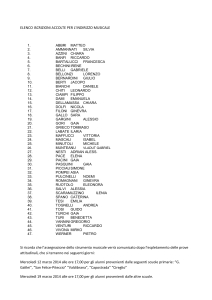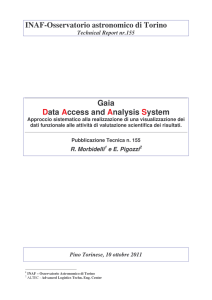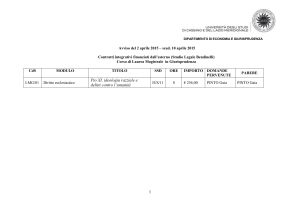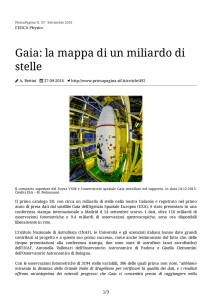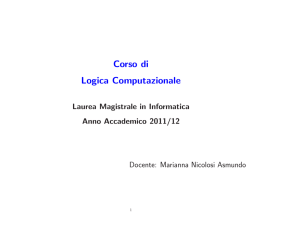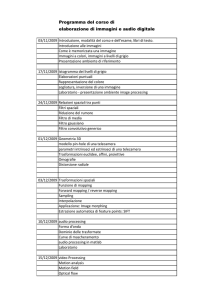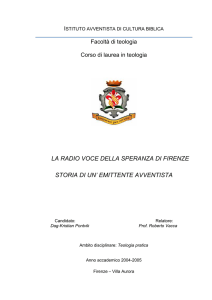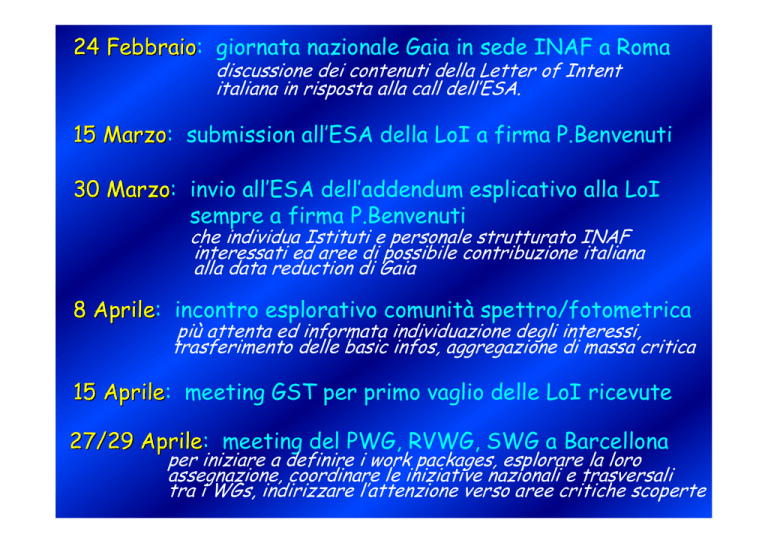
24 Febbraio:
Febbraio giornata nazionale Gaia in sede INAF a Roma
discussione dei contenuti della Letter of Intent
italiana in risposta alla call dell’ESA.
15 Marzo:
Marzo submission all’ESA della LoI a firma P.Benvenuti
30 Marzo:
Marzo invio all’ESA dell’addendum esplicativo alla LoI
sempre a firma P.Benvenuti
che individua Istituti e personale strutturato INAF
interessati ed aree di possibile contribuzione italiana
alla data reduction di Gaia
8 Aprile:
Aprile incontro esplorativo comunità spettro/fotometrica
più attenta ed informata individuazione degli interessi,
trasferimento delle basic infos, aggregazione di massa critica
15 Aprile:
Aprile meeting GST per primo vaglio delle LoI ricevute
27/29 Aprile:
Aprile meeting del PWG, RVWG, SWG a Barcellona
per iniziare a definire i work packages, esplorare la loro
assegnazione, coordinare le iniziative nazionali e trasversali
tra i WGs, indirizzare l’attenzione verso aree critiche scoperte
programma odierno
Ulisse Munari (Asiago) : tasks della spettroscopia
Paola Marrese (Leiden) : tasks della fotometria
Mario Lattanzi (Torino) : aggiornamenti contesto
internazionale
• discussione generale sul coinvolgimento italiano e definizione
delle sue linee guida da riportare al meeting di Barcellona
• definizione delle prossime azioni/riunioni italiane
Core Tasks :
essenziali alla fruibilità dei dati: ad es. è
core task la calibrazione in lunghezza d’onda e la
misura della velocità radiale, ma non la misura della
velocità rotazionale o l’analisi chimica. E’ core
l’individuazione delle “well behaving stars” (WBS) per
la GIS, non è core caratterizzare le proprietà delle
“not WBS”. Se le Core Tasks non sono coperte, ci
potrebbe essere un descoping di Gaia !
Shell Tasks :
sono attività rilevanti ma non cruciali.
Ad es. la pipeline riconosce che una stella è SB2, e la
toglie dalle WBS. Si può mettere un flag alla stella nel
catalogo Gaia finale e finire qui, oppure riconoscere che
è periodica e darne il periodo. Poi si puo’ andare avanti
e derivarne l’orbita spettroscopica. Step successivo
può essere valutarne la curva di luce (ci sono eclissi o
no ?). If yes, si può calcolare l’orbita e dare i parametri
stellari nel catalogo Gaia. Si può fare un passo ulteriore
e provvedere ad una sanity check con l’analisi atmosf,etc.
la riduzione e misura dati
spettroscopici di Gaia:
overview
work packages
interessi Asiago/Ljubljana
Ulisse Munari
INAF Osservatorio Astronomico di Padova
~100 epoch obs. per star
in 5 yr mission
spectra : 8480-8740 Å range
RVs to V ≤ 17.5
stars
spectra to V ≤ 15.0 150,000,000
photom.:
V ≤ 20
astrom.:
V ≤ 20
11 + 5 bands
one billion stars
4 µas
250 µas
(V<12)
(V=20)
10 µas
(V=15)
M3
sp
tr
ec
o
M2 M1
Hipparcos
80 passages
47o
Hipparcos
Æ
16 CCD
122sec transit Æ
Å 2o
6 CCD 118sec transit Æ
1.6 o
ÆÅ
Sky Mappers
1o
Å 2o
scan direction
dispersion direction
Å
GAIA spectrograph
and medium band
photometric unit
simulated images of one
transit (6 CCDs) of the
RVS focal plane
high gal. latitude
1000 star/deg2 V<17
low gal. latitude
6000 star/deg2 V<17
crowding effects on overlap of spectra
in units of the mission integrated
flux from a K1V star of V=17.0
high gal. latitude
1000 star/deg2 V<17
low gal. latitude
6000 star/deg2 V<17
background accumulated during whole mission
(stars with V<14 excluded)
contribution by the 10 brightest such stars
http://ulisse.pd.astro.it/Gaia_doc/
RVS processing: work packages
1000 Coordination
2000 Auxiliary data
3000 Simulations
4000 Database and initial data treatments
5000 Science Alert
6000 Calibrations
7000 Radial velocities
8000 Classification and parameterization
9000 Diagnostics, peculiar objects
10000 Background, interstellar medium
11000 Double and multiple systems
12000 Variable systems
Work packages detailed in the following viewgraphs:
• Draft list: need/will be iterated/revised
• Different levels of details from work package to work package
RVS processing: 1000 coordination
1000 Coordination
1100 Coordination (schedules, work overview & quality
control, communication)
1200 Architecture
1210 Core tasks architecture and sequencing
1220 Database architecture and access strategies
1230 Spectroscopic global iterative solution architecture
1240 Shell tasks architecture and sequencing
1300 Interfaces
1310 external interfaces (Gaia)
1320 internal interfaces (RVS)
1400 Algorithm integration and operational tests
RVS processing: 2000
Auxiliary data & 3000 Simulations
2000 Auxiliary data
2100 Atomic and molecular data
2200 Atmospheric models
2300 Reference spectra
2210 Observed spectra
2220 Synthetic spectra
2400 Photometric reference stars
2500 Radial velocity reference stars
3000 Simulations
3100 RVS instrument (optics, detectors and electronics)
3200 RVS data
3300 On-board RVS processing
3400 On-ground RVS processing
RVS processing: 4000
Database & initial data treatments
4000 Database and initial data treatment
4100 Database architecture
4110 Overall architecture
4120 Instrument layer
4130 Raw layer
4140 Intermediate layer
4150 Source layer
4200 Ingestion and initial data treatment
4210 Spectra extraction
4220 Source cross-matching
4230 Ingestion in the database
RVS processing: 6000 Calibrations
6000 Calibrations
6100 Calibrations: short time scale (24h)
6110 Data sanity check
6120 Calibrations for on-board processing
6200 Calibrations: long time scale (6 months) –
Spectroscopic Global Iterative Solution (SGIS)
6210 Characterisation of “well behaved sources”
6220 Selection of calibration sources
6230 CCD offset calibration
6240 RVS (optics + CCD) response calibration
6250 CCD defects mapping
6260 Wavelength calibration
6270 PSF profile calibration
6300 Data meta-processing
6310 Apply calibrations
6320 Cosmic rays filtering
6330 Spectra combination/co-addition
RVS processing: Tasks 7000 & 8000
7000 Radial velocities
7100 Early type stars
7200 Late type stars & asteroids
7300 Low signal to noise stars
7400 Spectroscopic binaries
8000 Classification and parameterization
8100 Discrete classifier
8200 Atmospheric parameters
8300 Abundances
RVS processing: Tasks 9000 & 10000
9000 Diagnostics and peculiar objects
9100 Stellar diagnostics
9110 Be phenomenon
9120 Mass loss (mass loss rate ?)
9130 …
9200 Minor planets properties
9300 Galaxy and quasar properties
10000 Background and interstellar medium
10100 Background modelling
10200 Interstellar medium properties
10210 Radial velocity
10220 Interstellar reddening
RVS processing: data interface
Satellite: attitude data
Same as detection data & astrometric data
Detection data
4210 spectra extraction
4220 source cross-matching
6120 calib. for on-board proc.
Astrometric data
5000 science alert
6120 calib. for on-board proc.
6210 char. of “wb” sources
6220 selection of calib. sources
6260 wavelength calibration
6310 apply calibrations
7000 radial velocity
8000 classification &
parameteriz.
9000 diagnostics & pec.
Objects
10100 background modeling
11000 double & multiple syst.
12000 variables
Photometric data
5000 science alert
6120 calib. for on-board proc.
6220 selection of calib. sources
6240 RVS response
6310 apply calibrations
11000 double & multiple syst.
7000 radial velocity
12000 variables
8000 classification &
parameteriz.
9000 diagnostics & pec. objects
10000 background &
interstellar medium
Very strong interconnectivity between astro-photo-RVS data
interactions/development
overlaps
Database group
1310 external interfaces
4110 DB overall architecture
4120 Instrument layer
4130 Raw layer
4140 Intermediate layer
4150 Source layer
4220 Source cross-matching
4230 Ingestion in DB
Simulation group
3100 RVS instrument
simulation
3200 RVS data simulation
3300 On-board processing
simu
3400 On-ground processing
sim
Calibration & quick look groups
6110 data sanity check
6230 CCD offset
6240 RVS response
6250 CCD defects
6260 Wavelength calibration
6270 PSF profile calibration
Astrometry and/or Photometry groups
1310 external interfaces
2400 photometric ref. stars
8100 discrete classifier
8200 atmospheric parameters
8300 abundances
9000 diagnostics & pec.
objects
10000 background modelling
& interstellar medium
Classification & science alert groups
5000 science alerts
8100 discrete classifier
8200 atmospheric parameters
8300 abundances
9000 diagnostics & pec.
objects
10000 background modelling
& interstellar medium
11000 Double & multiple stars group
12000 Variable stars group
Strong interactions/overlap for work package development
Task development “steps”
• Definition/selection of methods (astronomers)
– e.g. RV derivation (case by case): CC or Fourier transform?
Mask or template?
• Prototyping (astronomers)
– Test input/output – first assessment processing load
– Scientific optimisation and performance assessment
– Scientific robustness and test cases
• Operational algorithm (software engineers)
– Software optimisation
– Algorithmic/software robustness and test cases
• Integration and operational tests (DB & software
engineers / astronomers)
Strict scheduling & precise deliverables
Organization: a possible scenario
Simulation Group
Astrometry Group
Institute 1
Task(s) development
Institute 2
Task(s) development
Institute n
Task(s) development
RVS Group
Coordination group
(one/several inst.)
Architecture
Scheduling
Interface
Quality control
Database group
Data storage
Photometry Group
Classification Group
…
Group
Processing coordination group
Algorithm integration
Processing controller
Institutes interests
Early February status: potentially interested institutes
Antwerp
Bordeaux
Cambridge
CNES
Groningen
Ljubljana
Meudon
Montpellier
Nice
MSSL
April/Mai expected status:
• Answers to Letter of Intent (done)
• Joined RVS/Photometry/Classification workshop (April 27-29)
→ refined list of interested institutes
→ first assessment of total FTE
→ first assessment of work package/tasks coverage
interessi per la data reduction spettroscopica
Asiago
Ljubljana
Binarie ad eclisse
RAVE test bed
Tests con telescopi a terra
Reddening da 8620 Å DIB
Librerie spettri sintetici
Anomalie chimiche
Stelle a spettro peculiare
Spectroscopic Science
Alerts
Schemi di χ2 e crosscorrelazione evoluti
(ad es. per [Fe/H]<-1.0)
Analisi atmosferica
automatizz. degli spettri
Velocità rotazione
a bassi Vrotsini
Disentangling
dell’overlapping
Zero point delle Rad.Vel.
con gli asteroidi
Detection of periodicities
Quasars/AGN detection


